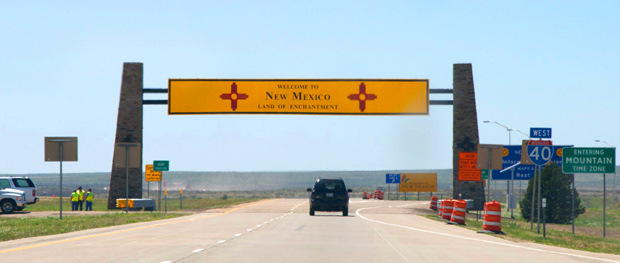Early last month I detailed my plans for moving to California for friends, a change of scenery and of course the acclaimed high-tech hub in the San Francisco Bay Area. Many have contacted me asking to share my experiences on what it is like to move cross-country — in particular to San Francisco — as they were looking to do the same pretty soon. I will attempt to chronicle my journey and adaptation to San Francisco in this and possibly future blog posts.
Apartment Hunting
I first scheduled a weeklong trip to San Francisco to get more oriented with the city and find out what neighborhoods I liked. I told myself I would not depart until I had signed a lease and received the keys to my new apartment. I had planned on couch surfing at several friends' apartments but Noah Kagan (with whom I had worked on some Mint.com marketing years ago) of the not quite launched AppSumo was gracious enough to let me stay on his couch for the entire week. Once I got settled in on Noah's couch I spent several hours each day browsing two great apartment listing mashups — PadMapper and HotPads.
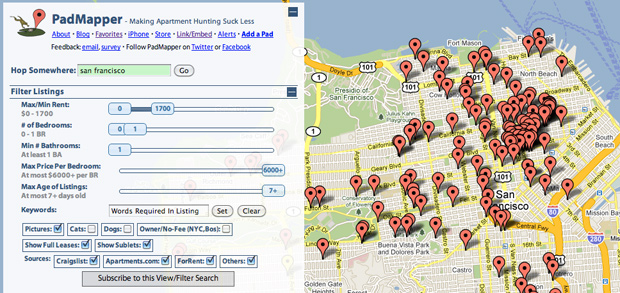
My first objective was to get a sense for what neighborhood I wanted to live in. A bunch of Googling, walking around and talking with friends helped me figure that out. The SF Gate has a great section explaining neighborhoods, their restaurants, attractions and so on. I narrowed down my search to Hayes Valley, Duboce Triangle and the Mission. For example, here's a snippet of what SF Gate says about the Mission:
The Internet boom brought on heavy gentrification -- trendy restaurants and boutiques blazed in, rents shot up and many Latinos and artists were displaced by the influx of highly paid young professionals. Today, there's an interesting mix of places that survived the changes and new arrivals that are trying to make the Mission home. [...] Generally speaking, the 24th Street area is the culturally rich heart of the Mission, the stretch from Dolores Street through to Valencia Street is young and upscale, the area around 16th and Valencia streets hops with nightlife and the industrial area near Bryant Street has some hip, trendy restaurants.
It did not take long before I needed to adjust my expectations to fit within my budget. I was expecting to land a 600-700 square foot 1-bedroom apartment in a decent neighborhood for around 1,200. Yeah, that was not going to happen. In Atlanta I leased a 723 square foot 1-bedroom loft for 975/month in a favorable part of town with included parking, in-unit washer and dryer, microwave, garbage disposal, central heat and air conditioning and a dishwasher. The same in San Francisco would cost around 1,800-2,200/month and very likely not include several of those amenities. My priorities changed and I focused instead on finding a 400-500 square foot studio with in-building laundry. That was going to be enough of a challenge.
The first few days were hectic to say the least. I would browse for a while, find something decent, then call to ask questions only to be let down every single time. One particular place seemed to fit the bill then I called to find out it was under 300 square feet. Another place seemed great online and in the pictures then I started walking in the neighborhood and quickly realized it was not an area I wanted to live in (16th & Mission - near the BART station). This happened a few more times. It then became a game of catching new listings as they were posted; so I was online a lot that week. If I wasn't restricted to my short timeframe (I had to move before my lease was up in Atlanta), the best solution would be to setup a script to notify me of new listings that matched my preferences. That's exactly what Nick Bushak did for a private Google group of hackers that were trying to find a summer "Hacker House." I was initially looking to live with them but the timing did not work out.
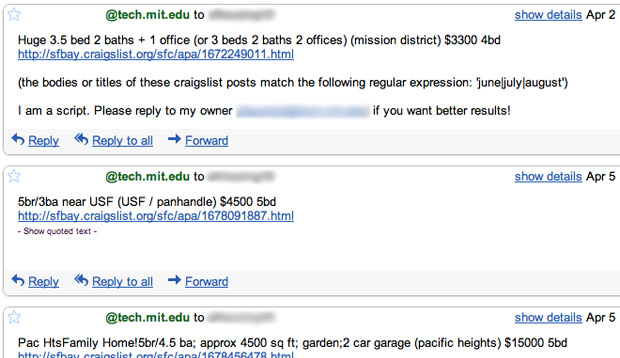 Having something or someone else search for you is probably one of the better ways to deal with long-term apartment hunting. For example, Noah outsourced his apartment search to an overseas assistant for 4/hour that found listings according to his preferences, made viewing appointments and added them to his calendar.
Having something or someone else search for you is probably one of the better ways to deal with long-term apartment hunting. For example, Noah outsourced his apartment search to an overseas assistant for 4/hour that found listings according to his preferences, made viewing appointments and added them to his calendar.
On the fourth day of apartment hunting I stumbled upon a great listing within hours of its posting. It was a studio in the Mission District with a secured parking garage (for extra of course), newer construction (likely 1970s — much better than the 1920s buildings I had seen in most listings), RFID entry and in-building laundry facilities. I went on Twitter to ask my friends what they thought of the exact area and all seemed to like it.
 Listing photos are incredibly deceiving... this lamp was not included with the apartment.
Listing photos are incredibly deceiving... this lamp was not included with the apartment.
I scheduled a viewing appointment for the same day, in between two other apartment viewings I had booked earlier. I got to the neighborhood an hour early, walked around and stopped by a coffee shop with lots of character that Nivi recommended. I sat down and chatted with some of the locals to see what they thought of the area and what it was like at night. It turned out I had been chatting with someone that graduated from UGA (my alma mater's rival). Then I went to the apartment viewing and was pleased to hear the leasing agent say I was the first person to view the apartment. She also mentioned many Google employees live in the building since their shuttle picks up nearby. The kitchen was smaller than I had hoped for — actually the entire place was smaller than I had in mind (probably 375-400 square feet at best) — and the oven was tiny (I cook a lot), but I was going to deal with it. I filled out the paperwork that day.
 A tiny studio but definitely livable. Notice custom Cat 6 stapled to the wall. Only took three tries to get the T568A pinouts right. In hindsight investing in a dual-band wireless N router (currently just 802.11g via WRT54G2 — will install DD-WRT soon just tonight my WRT54G2 died and I swiftly replaced it with a 1TB Time Capsule) would have worked almost as well, but the AirPort in my MacBook Pro still needs cycling fairly often.
A tiny studio but definitely livable. Notice custom Cat 6 stapled to the wall. Only took three tries to get the T568A pinouts right. In hindsight investing in a dual-band wireless N router (currently just 802.11g via WRT54G2 — will install DD-WRT soon just tonight my WRT54G2 died and I swiftly replaced it with a 1TB Time Capsule) would have worked almost as well, but the AirPort in my MacBook Pro still needs cycling fairly often.
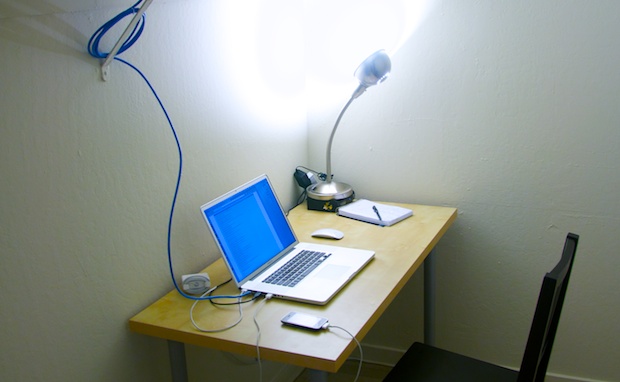 Ikea desk and chair were just under 100. I will be keeping an eye out for deadpooled startups that sell their Herman Millers for cheap.
Ikea desk and chair were just under 100. I will be keeping an eye out for deadpooled startups that sell their Herman Millers for cheap.
The mechanics of actually getting them to approve me for the apartment requires some explaining. Landlords and leasing agents in San Francisco are rather aggressive. Many apartments have open house viewings often. I had heard of some nightmare situations when it came to these open houses; that everyone would have their checkbooks out, proof of income, pay stubs, credit reports printed out and were ready to sign the lease right there. I was particularly nervous about the whole situation as I was unemployed when looking for an apartment and had no verifiable income that I could list. The only thing I had in my favor was a good credit score from the three credit bureaus. I was able to find this out easily with American Express CreditSecure credit report monitoring (2 for the first month, then cancel immediately). The FTC lists authorized, free ways to acquire your credit report but I am not sure whether their recommended service can get the report the same day. Some apartment listings state they will waive the application fee if you come to the viewing with a recent credit report in hand.
I got a call back from the leasing agent saying that the landlord gave me two options: I could get a cosigner or since I had a good credit score they would let me sign the lease if I provided two months rent (2x security deposit) in addition to the first month's prorated rent. I chose the latter option as it would be quicker and help my credit score in the long-run. That meant I had get a hefty cashier's check made before I got the keys to the apartment.
In no particular order, here are some random apartment things I learned during my hunt and lease signing process:
- You don't need air conditioning in San Francisco. It's mid-May and I have my heater on right now. Though I did purchase a small Vornado fan ("air circulator") for the few summer days that it does reach 80 degrees in the city.
- In-unit washer and dryer is just about impossible to find. Same with dishwasher. If you find an in-building washer and dryer, you're sitting pretty.
- Just about everything is early 1900s construction and has hardwood floors. In fact many listings love pointing out period details, stating Edwardian this or Victorian that.
- Many apartments with hardwood floor state in the lease that tenants must cover 80% of the floor with carpet to alleviate noise issues for neighbors. To give you an idea, a 6' by 10' carpet from Ikea costs 199 and you would need two to make it look like 80% of the floor was covered. Keep that in mind. Of course there are definitely cheaper places to buy carpet.
- You get two pamphlets when you sign your lease: how to deal with lead-based paint and how to survive natural disasters like fires and earthquakes.
- While getting renter's insurance you will be asked if you want to buy earthquake insurance (doubles the price). The local Best Buy sells "Quake Straps" to fasten your TV to the wall.
- It's important to ask the leasing agent if previous tenants have (successfully) had DSL/Cable installed prior. Buildings built in the early 1900's don't have the best wiring and that may affect signal quality and thus performance.
- There is an ISP called Web-Pass that offers FTTH for certain properties. Check to see if those properties have any apartment listings because the service is great: 45 or 100 megabit. Otherwise Comcast offers up to 50 megabits down with their "Extreme 50" plan — if the 250GB/month bandwidth cap does not bother you.
- It takes Comcast at least a week to come for an installation appointment. If you're lucky one of your friends will have a Sprint Overdrive or Verizon MiFi you can borrow.
- Buying a bed? Most places deliver same day for free (but it's implied you tip them). I got my queen, box spring and frame from a place called Sleep Train.
Obvious Pro Tip: Save up before heading out to San Francisco while unemployed. If you plan on living by yourself, I would say at least 5,000-7,500 would be a decent number to have in mind if you can live somewhat frugally. Otherwise, and especially if you are moving cross-country, 8,000+ would be best. Friends that have moved to San Francisco through work received ~10k relocation bonuses, so that's what their companies value the move at. Please leave a comment below if you have thoughts on this.
Moving
 #roadtrip: gas ~350, hotels ~370
#roadtrip: gas ~350, hotels ~370
I spent some time deciding how I wanted to move. Should I rent a U-Haul truck and car trailer to drive out? Or should I rent the U-Haul and have my car shipped out? Or maybe I should have my stuff sent out in a shipping crate while I drive out or perhaps I just leave the car at home and fly out? Eventually I went back to one of my favorite Paul Graham essays, Stuff, and read it again. I took that to heart and sold or donated as much of my stuff as I could with ease.
-
My 50-inch plasma HDTV, surround sound system, PS3, Roku player, Vudu box, Core i7 + Windows 7 Gaming/Boxee/Home Theater PC, 24-inch Dell monitor and 23-inch Samsung monitor? Sold.
-
Desk, Herman Miller Celle chair, bed, dresser, couch, coffee table, lamps and two large SumoSac contraptions? Sold/Donated.
-
Zooey, my beloved black labrador? I found her a loving new home where she will be much happier than in a small San Francisco studio apartment while I am out much of the day.
Surprisingly, I sold almost everything through Twitter and Tumblr. This made sense financially as well — a shipping container would have cost 1,600 for port to port delivery which requires renting a truck to load and unload, or 2,400 for door to door delivery. Another alternative would have been shipping some boxes on a pallet. I believe that runs in the 400-600 range.
A few small boxes, a suitcase and my laptop remained. And my AT&T 3G MicroCell because their network sucks everywhere I go and at the very least I want good signal at home. If you are in the same boat, I highly recommend you consider the MicroCell. Aside from a few dropped calls when my iPhone switches between the MicroCell and a regular cell tower, I am very happy with the MicroCell.
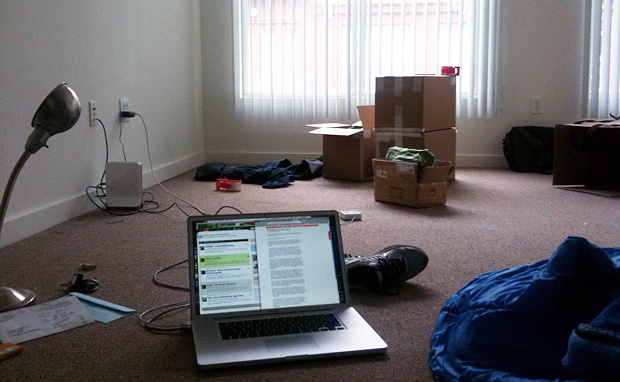 Empty apartment in Atlanta
Empty apartment in Atlanta
With just those few possessions left I decided to make the move via car. Before departing from Atlanta I partnered up with Richard LeBer of Atlanta Startup Drinks and Rick Myers of Talent Zoo and Strongbox West coworking facility to have a special Startup Drinks/Stammy farewell party. Entrepreneur Tim Dorr, whose company A Small Orange hosting was recently acquired, graciously sponsored the event.
I can't say thanks enough to everyone in Atlanta for coming out to Startup Drinks to say goodbye to me! Atlanta-based rapper T.I. made an appearance of sorts at the gathering; his rap studio Grand Hustle Records happens to be next door.
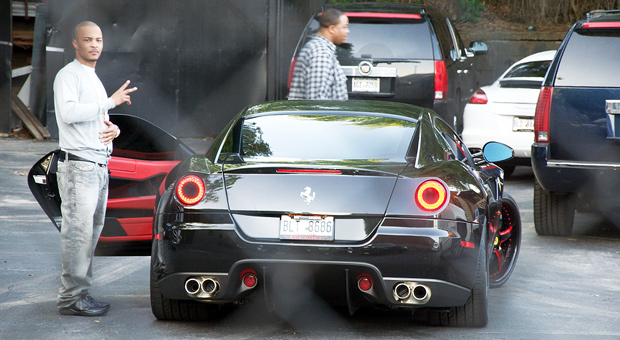 T.I. posing with his Ferrari 599 (320k+) after @marisasharpe asked him if I could take his picture. Note his new white Porsche Panamera in the background — he mentioned that car in the song "Winner" feat Jamie Foxx and Justin Timberlake. That's his second Panamera; he also bought his lady friend a black Porsche Panamera Turbo (130k+).
T.I. posing with his Ferrari 599 (320k+) after @marisasharpe asked him if I could take his picture. Note his new white Porsche Panamera in the background — he mentioned that car in the song "Winner" feat Jamie Foxx and Justin Timberlake. That's his second Panamera; he also bought his lady friend a black Porsche Panamera Turbo (130k+).
And some obligatory road trip pictures.
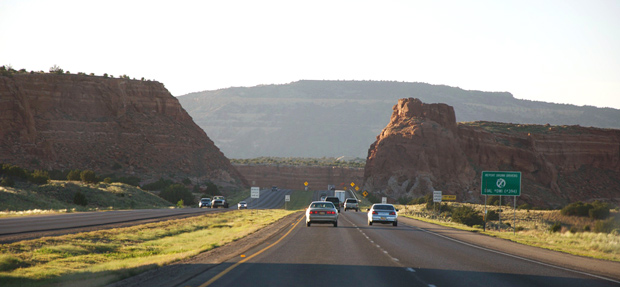 The landscape started getting interesting in New Mexico. Everything else East made for a boring drive.
The landscape started getting interesting in New Mexico. Everything else East made for a boring drive.
 Pipe Creek Vista — Grand Canyon, South Rim in Arizona
Pipe Creek Vista — Grand Canyon, South Rim in Arizona
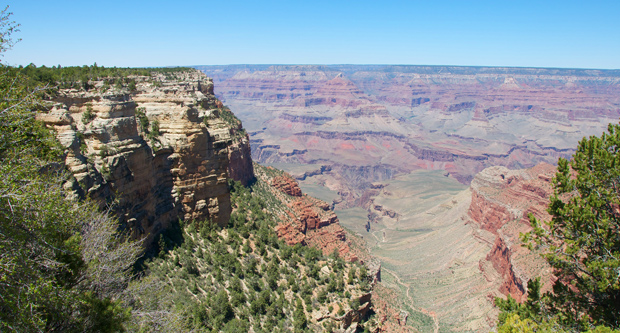 This picture definitely does not do the Grand Canyon justice. I highly recommend visiting.
This picture definitely does not do the Grand Canyon justice. I highly recommend visiting.
 Crossing the Bay Bridge
Crossing the Bay Bridge
The City
The first thing I wanted to learn about San Francisco was getting around with public transportation. Coming from Atlanta, which is definitely a car city, I had lots of catching up to do. For those unfamiliar with transportation in the bay area, there are quite a few options: Caltrain, BART, Muni, AC transit, VTA light rail (south bay) in addition to taxis, ZipCar and City CarShare. If you take public transit with any regularity you will probably want to get a TransLink card (soon to be renamed Clipper). Otherwise keep some crisp dollar bills on hand at all times for Muni. There's nothing worse than holding up a line of people trying to get on the bus while you try to cram in two crumpled dollars into the machine.
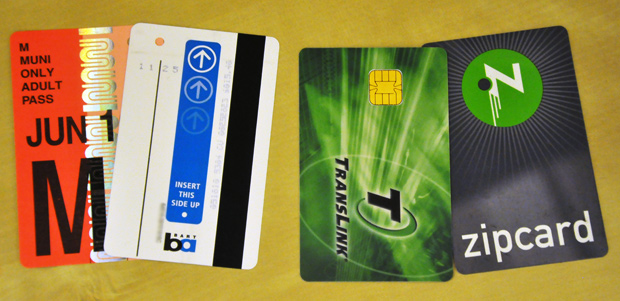 Left to Right: monthly Muni pass (60. getting phased out by TransLink), BART pass (TransLink can also do this), TransLink card, ZipCard.
Left to Right: monthly Muni pass (60. getting phased out by TransLink), BART pass (TransLink can also do this), TransLink card, ZipCard.
Other things I've learned:
-
Last Caltrain out of San Francisco leaves at midnight. Muni runs 24 hours. BART stops running at midnight and resumes 4am on weekdays, 6am on Saturdays and 8am on Sundays.
-
It's always chilly. I have yet to get a chance to wear shorts. I went to Union Square and got some more jeans the first week. I will probably need to get another windbreaker. Gabor told me he quickly learned that everyone out here wears button-up shirts when going out, so he had to beef up his wardrobe in that regard.
-
It takes about 30 minutes to get to downtown from the Mission on Muni (only 2-3 miles). On BART or underground Muni rail it's more like 10 minutes.
-
The most I've had to pay to get across town (well, almost across town: Mission to North Beach) via taxi was 15. Mission to downtown is about 8 (not including tip). (First 1/5th mile is 3.10 with every additional 1/5th mile or minute adding 45 cents.)
-
Yellow and Luxor cabs accept credit/debit cards.
-
Keep an eye out for some parts of Market Street that have taxi/bus-only left lanes.
-
Driving in San Francisco takes some getting used to because the traffic lights are usually on the sides, not hanging above the intersections.
-
Finding a cab in SoMa once a Giants game lets out is rather difficult.
-
iPhone Google Maps has excellent public transit information but can drastically tell you different routes just to get you on a bus/train sooner, even if the trip might be longer. Tinker with changing your departure time. Alternatively there are many iPhone apps for transportation info: Taxi Magic, MyCaltrain, iCommute SF, Pocket Muni, iBart Live. NextMuni.com is also useful.
-
Do not fall asleep on BART or you will miss the Embarcadero stop and end up in Oakland. I speak from experience and a series of entertaining tweets.
-
Two Ikeas: Emeryville just across the Bay Bridge and in East Palo Alto
-
There is a Pinkberry near Stanford campus. Fraiche Yogurt in Palo Alto is great too — Steve Jobs has been spotted there before. Watch the Scoble interview.
-
Tea tasting is the thing to do in Chinatown. Also, Ten Ren at 949 Grant Ave is a great place for 3 tapioca bubble tea.
-
Blue Bottle Coffee is popular here. Visiting Blue Bottle Cafe at 66 Mint St is a must.
-
People here were not joking around; AT&T is horrible in San Francisco. In particular I have noticed many dead spots around the Mission.
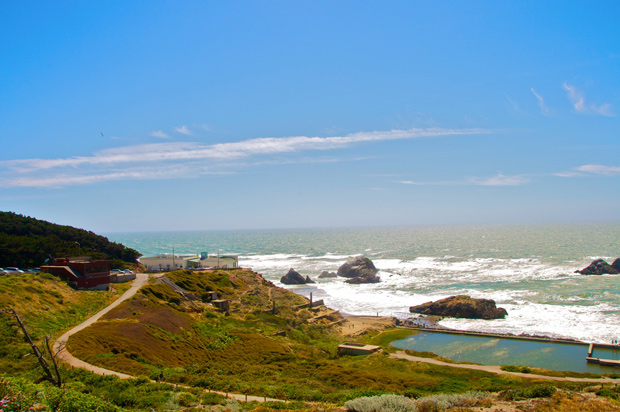 Ocean Beach in San Francisco near Cliff House and Sutro Baths
Ocean Beach in San Francisco near Cliff House and Sutro Baths
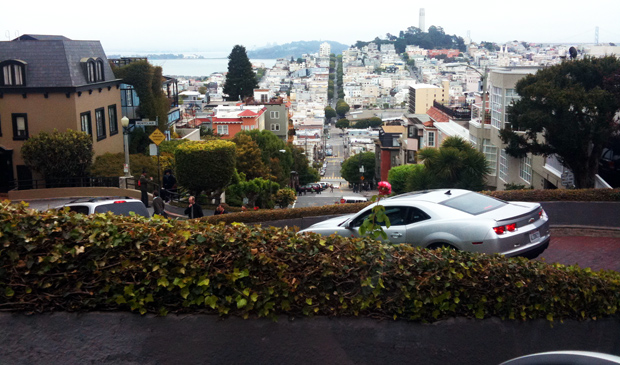 Driving down Lombard like a tourist.
Driving down Lombard like a tourist.
In Short: For someone coming from Atlanta, SF Public transportation is great. I brought a car out here and now I'm already thinking about getting rid of it. Related: parallel parking on a steep hill with a manual transmission is annoying.
Thoughts
I have now been in San Francisco for exactly two weeks and I am in love with the city. Hopefully this honeymoon period does not fizzle away too soon.
Any questions? Have any of you made a cross-country or other such long-distance move before? Reading this and live in San Francisco? Let's meetup some time.


